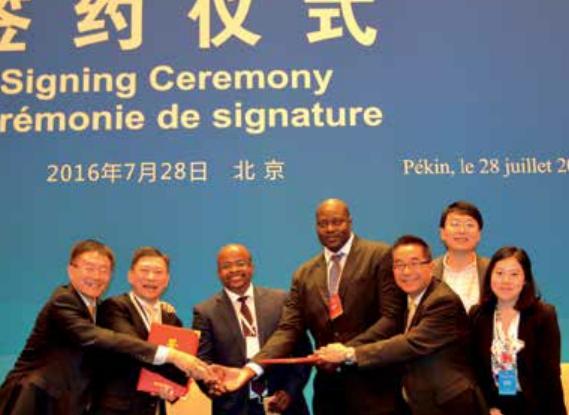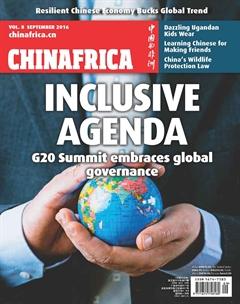Investment Stimulus
By Liu Jian

Limpopo province in the far north of South Africa takes its name from the mighty Limpopo River, which forms the natural border with Zimbabwe. It is a region teeming with wildlife, and bountiful historical and cultural treasures, along with spectacular scenery.
Now the province, and its northern-most town, Musina, are on the verge of bigger things.
Shenzhen Hoi Mor Resources Holdings Ltd., a Chinese company specialized in mineral beneficiation, will invest more than $3.8 billion to establish an energy and metallurgical industrial cluster in the Musina Special Economic Zone (SEZ).
Richard Zitha, Project Executive of the Musina SEZ under Limpopo Economic Development Agency, is pleased with the positive outcome of his recent trip to China, where he signed a cooperation agreement with Shenzhen Hoi Mor Resources at the Seminar on ChinaAfrica Business Cooperation on July 28, 2016 in Beijing.
“This cluster provides a golden opportunity for our skills upgrading and technology transfer and has demonstration effects,” he told ChinAfrica. “These dynamic effects have the potential to contribute further to regional development, especially in the long term.”
According to Ning Yihai, Chairman of Shenzhen Hoi Mor Resources, the cluster consists of around 10 projects including a power plant, a coking plant, a ferrochrome plant, a steel plant and a stainless steel plant. He noted that a joint venture will be set up to develop and manage the cluster.
“The implementation of various projects over the next five years is expected to create more than 21,000 jobs,” he said. “Capacity building and skill development are the key areas we will focus on in our cooperation, and we will also increase value-added production.”
Industrial cooperation
“The development of this SEZ is intended to accelerate economic growth, attract foreign and domestic direct investment, expand the manufacturing sector and mineral beneficiation, as well as create employment in the region,” said South African Trade and Industry Minister Rob Davies.
Ning told ChinAfrica that for the project, his company can apply for funding from the China-Africa Development Fund (CADFund) or the China-Africa Fund for Industrial Capacity Cooperation. Both of them were established by China in 2006 and 2015 respectively to support more Chinese companies to invest in the continent.
China and South Africa complement each other well in industrial capacity cooperation, said Wang Fuqiang, Vice President of Shenzhen Hoi Mor Resources. “The Musina SEZ has the advantage of rich natural resources and enjoys South African Governments preferential policies in tax and foreign investment, while our company has the leading metallurgical technology and equipment, and [our products enjoy] huge market demand,”he explained.
But it is not only South Africa that China is now deeply involved with, but the continent as whole. Africas industrialization and agricultural modernization have a focus on financing and investment cooperation, said Chinese Foreign Minister Wang Yi while delivering a work report at the Coordinators Meeting of the Implementation of the Follow-up Actions of the Johannesburg Summit of the Forum on China-Africa Cooperation (FOCAC) on July 29, 2016 in Beijing.
“Investment cooperation has become a new way of boosting China-Africa cooperation, and its a mutually beneficial cooperation model,” said Wang. “It helps speed up Africas industrialization and improve its independent development capacity, while bringing Chinese equipment, technologies and products to African countries via industrial capacity cooperation,” he added.
Egypts Assistant Foreign Minister for African Affairs Mohamed Edrees told ChinAfrica that the industrial development cooperation mentioned by Wang is something most African economies are looking for. He said there is now a realization in Africa that to achieve significant development in a variety of fields, there must be industrial development and not just dependence on agriculture, as is the case across the continent.
The multiplier effect
At the FOCAC Johannesburg Summit held in South Africa last December, Chinese President Xi Jinping announced 10 major China-Africa cooperation plans for 2016-18, backed by grants, funds, zero-interest loans and loans on favorable terms valued at $60 billion.
Eight months later, more than 100 Chinese and African ministerial officials attended the coordinatorsmeeting on July 29 to evaluate and review the implementation of agreements reached at the FOCAC Summit in Johannesburg.
Since the summit, China and Africa have signed 243 cooperation agreements of various kinds worth $50.725 billion, said Chinese Vice Foreign Minister Zhang Ming at the press briefing after the meeting.
“Among the agreements, Chinese companies direct investment and commercial loans to Africa exceed $46 billion, accounting for 91 percent of the total volume, covering the areas of industrial cooperation, special economic zones, power plants and agricultural projects,”he said.
Zhang believes the achievement of the FOCAC Johannesburg Summit has revitalized the market to boost China-Africa cooperation, calling this the “multiplier effect.”
“Like a catalyst, Chinas $60-billion Africa-focused funding speeds up the rate of the chemical reaction of China-Africa cooperation in the market environment, which has successfully brought a large amount of funding from the market, and attracted more investment to Africa,” said Zhang.
Addressing bottlenecks
The specific cooperation blueprint in place revolves mostly around industrialization.
“The 10 cooperation plans include a China-Africa industrialization plan, an agricultural modernization plan and an infrastructure plan, which will address the bottlenecks holding back Africas development such as inadequate infrastructure and lack of talents,” said He Wenping, Senior Research Fellow at the Institute of West Asian and African Studies of the Chinese Academy of Social Sciences.
Under the China-Africa industrialization plan, China has signed cooperation agreements with countries on building trade and economic cooperation zones, said Chinese Minister of Commerce Gao Hucheng, while delivering a speech on the progress China has made in implementing the new economic and trade measures of the 10 cooperation plans at the Coordinators Meeting. “The expansion project of the China-Egypt Suez Economic and Trade Cooperation Zone has started, and Ethiopia has launched the Hawassa Industrial Park,” he added.
Chinas financial support has helped address Africas funding shortages and laid the foundation for development in all sectors, according to Gao. An additional capital of $5 billion has been injected into the Special Loan for the Development of African Small- and Medium-sized Enterprises since the Johannesburg Summit. China has extended $100 million in loans for five projects in five African countries, while the CADFund has invested another$100 million in seven projects in six African countries.
And at the top of the agenda in the thrust of ChinaAfrica industrial cooperation are skills development and capacity building. Since the summit last year, China has trained more than 30,000 African technical personnel on site and hosted more than 6,000 officials and technical staff in 150 multilateral and bilateral training programs in China, said Gao in his report. “China will also help Africa set up 24 regional vocational education centers and schools for capacity building,” he said.
In an effort to see Chinas development progress first hand, a group of more than 90 participants, including African ministers and ambassadors to China, visited China-Singapore Suzhou Industrial Park in Suzhou City, Jiangsu Province on July 30.
“We are impressed by how Suzhou has developed its industrial parks in a short period of time, and how this generates modernization, industrialization and job creation, and this is what Africa is trying to emulate,” said Anil Sooklal, South Africas Coordinator of Implementing Agreements at the Johannesburg Summit and Deputy Director General of the countrys Department of International Relations and Cooperation.
“What better partner [to] have than a country that has experienced it and [is] now willing to share the experience with us? Thats why the partnership is so intense,”he added.

